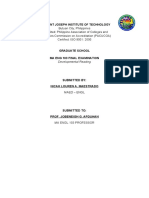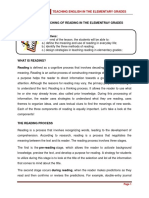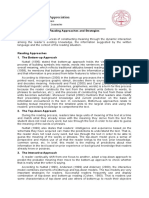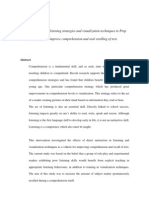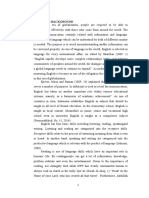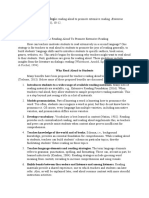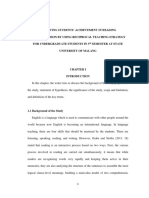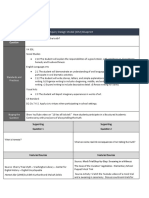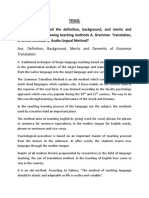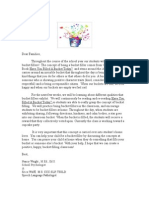0 ratings0% found this document useful (0 votes)
225 viewsTled 432 Final Exam Essays
Tled 432 Final Exam Essays
Uploaded by
api-375469242The document discusses strategies that a teacher, Mr. Jones, can use to help improve a struggling student's reading comprehension. It describes how Mr. Jones can teach previewing strategies to activate prior knowledge before reading. It also recommends teaching text structure for expository texts to help understand the author's purpose and main ideas. The document further suggests using literature circles and discussions to develop listening skills and make text connections. It concludes by advocating for teaching summarization skills to improve comprehension of both narrative and expository texts.
Copyright:
© All Rights Reserved
Available Formats
Download as DOCX, PDF, TXT or read online from Scribd
Tled 432 Final Exam Essays
Tled 432 Final Exam Essays
Uploaded by
api-3754692420 ratings0% found this document useful (0 votes)
225 views9 pagesThe document discusses strategies that a teacher, Mr. Jones, can use to help improve a struggling student's reading comprehension. It describes how Mr. Jones can teach previewing strategies to activate prior knowledge before reading. It also recommends teaching text structure for expository texts to help understand the author's purpose and main ideas. The document further suggests using literature circles and discussions to develop listening skills and make text connections. It concludes by advocating for teaching summarization skills to improve comprehension of both narrative and expository texts.
Original Title
tled 432 final exam essays
Copyright
© © All Rights Reserved
Available Formats
DOCX, PDF, TXT or read online from Scribd
Share this document
Did you find this document useful?
Is this content inappropriate?
The document discusses strategies that a teacher, Mr. Jones, can use to help improve a struggling student's reading comprehension. It describes how Mr. Jones can teach previewing strategies to activate prior knowledge before reading. It also recommends teaching text structure for expository texts to help understand the author's purpose and main ideas. The document further suggests using literature circles and discussions to develop listening skills and make text connections. It concludes by advocating for teaching summarization skills to improve comprehension of both narrative and expository texts.
Copyright:
© All Rights Reserved
Available Formats
Download as DOCX, PDF, TXT or read online from Scribd
Download as docx, pdf, or txt
0 ratings0% found this document useful (0 votes)
225 views9 pagesTled 432 Final Exam Essays
Tled 432 Final Exam Essays
Uploaded by
api-375469242The document discusses strategies that a teacher, Mr. Jones, can use to help improve a struggling student's reading comprehension. It describes how Mr. Jones can teach previewing strategies to activate prior knowledge before reading. It also recommends teaching text structure for expository texts to help understand the author's purpose and main ideas. The document further suggests using literature circles and discussions to develop listening skills and make text connections. It concludes by advocating for teaching summarization skills to improve comprehension of both narrative and expository texts.
Copyright:
© All Rights Reserved
Available Formats
Download as DOCX, PDF, TXT or read online from Scribd
Download as docx, pdf, or txt
You are on page 1of 9
Dorothy Fannin
TLED 432 Final Exam, Spring 2018
Question Two Response:
Critical literacy through reading comprehension is the ultimate goal for every student. As adults,
we must be informed citizens who contribute to the understandings and resolutions of social
injustices across a spectrum. This type of critical comprehension is impossible without first
having the ability to have literal explicit comprehension, followed by the ability to have deeper
implicit comprehension. As informed citizens, we must be able to “read between the lines.”
Educators share the paramount responsibility of meeting these long-term goals in students’
abilities to read and comprehend. Using the Four Patterns of Practice, incorporated with
researched-based instruction, educators can best meet students’ needs.
The previewing portion of the reading process has been determined to be an important phase of
reading. By teaching explicit previewing strategies to his student, Mr. Jones can get her started
on the path to reading comprehension. Mr. Jones can teach his struggling student how to activate
prior knowledge before she reads. He can model how to preview, for example, by creating a
word web using a key word from the title of a piece of literature. He can then link associations
to the key word and ask her to make predictions. Writing about, visualizing, and drawing
predictions could aid the prereading strategy that helps the student get off to a good start before
she even begins to cover the text. Effective previewing strategy use will enhance student reading
comprehension.
Because Mr. Jones’ student has difficulties with implicit comprehension of expository passages
as well as narrative, he could use the method of text structure instruction to enhance her ability to
comprehend material. Hebert, Bohaty, Nelson, & Brown (2016) identify the five structures of
expository text to be description, sequence, cause/effect, compare/contrast, and problem/solution.
There are several reasons that text structure instruction could be effective for improving reading
comprehension. First, if the reader understands the structure of the expository text, she can
better understand the author’s purpose. She can also use text structures to internalize her own
organization of ideas and can come to a better knowledge of which information is most
important. Recognizing signal words would help Mr. Jones’ student understand text structure.
Therefore, he could use instruction of recognition of signal words to understand text structure,
which will allow the student to reach her comprehension goals.
The language art of listening tends to be neglected in education. Listening skills can be taken for
granted, and it may be assumed that a student has naturally acquired the listening skills which
will foster reading comprehension. Students unknowingly use listening strategies, but the
explicit instruction of listening strategies can benefit those in need of assistance in many forms,
including implicit reading comprehension. Mr. Jones, for example, could use either Literature
Circles or Reading Workshop opportunities for development of his student’s struggling
comprehension. Teaching the strategy of connecting during aesthetic listening activities, he
could work toward the goal of critical literacy. By incorporating interesting literature that his
student can relate with, text-to-self connections could be fostered. Mr. Jones could encourage
his student to make personal connections between the text and her life. Second, text-to-text
connections can be encouraged by choosing literature with common themes or literature that can
be connected to TV shows or movies with which his student is familiar. Finally, Mr. Jones could
provide literature including topics relevant in the grander scheme of text-to-world connection
possibilities. By providing Literature Circles and Reading Workshop literary opportunities for
connections and encouraging his student to discuss connections during the story, Mr. Jones could
help his student to develop and employ this listening strategy to foster implicit comprehension
(Tompkins, 2010).
The Russian psychologist Lev Vygotsky (1896-1934) believed the social contexts of learning are
imperative and children learn through socially meaningful interactions. Another practice which
Mr. Jones could use to foster the development of reading comprehension in his student involves
providing opportunities for and encouraging student discussions of texts. Maine (2014)
describes the process of comprehension as “making meaning from text.” This process of making
meaning goes beyond decoding and explicit comprehension. It reaches deeper toward the goal
of critical literacy. Elaborating on Vygotsky’s social contexts of learning theory, Maine (2014)
suggests that students read and discuss texts together, allowing for the co-creation of meaning of
texts. Through discussion, students have the opportunity use their imaginations and empathy to
immerse themselves in the text. They use open and questioning communication to make
connections within the text and between each other. Further, listening to children as they have
discussions about text allows for opportunity to assess their thinking processes. This type of
ongoing and formative assessment could be used to determine additional means and methods for
teaching the struggling student.
Finally, Gunning (2016) cites the reading strategy of summarizing as the most effective strategy
toward reading comprehension. The instruction of strategies is described in a six-part process:
introduction of the strategy, modeling of the process, guided practice, application, assessment
and reteaching, and reviewing. Introduction of summarizing does not necessarily have to be
written. After modeling by summarizing examples, Mr. Jones can lead the student into guided
practice. Summarizing can initially be an oral activity. Mr. Jones could begin with having his
student engage in a retelling of the story, scaffolding with questions that will emphasize the main
idea and major events. He could not only use the strategy of summarizing with narrative text,
but he could also use this strategy with expository passages. By using textual clues such as titles,
illustrations, and headings, a student can learn to summarize expository text as well as narrative.
Using research-based methods of instruction in the Literature Circles and Reading Workshop
components of the Four Patterns of Practice in his classroom, Mr. Jones could foster greater
implicit comprehension among his students. By encouraging the usage of tools such as word
webs to introduce previewing, he could get his student started on the path toward deeper
comprehension. Mr. Jones could also use text structure instruction for expository works. This
would improve comprehension of expository text, which is also challenging for his student.
Emphasizing the language art of listening, he could encourage the process of making connections
with text-to-self, text-to-text, and text-to-world. Providing many opportunities for student
discussion of texts will further aid in comprehension. Finally, the important skill of
summarization could be taught to Mr. Jones’ student to improve her reading comprehension.
Using these five strategies will lead to the ultimate success and critical literacy of the struggling
student.
References
Bishop, P. A., Reyes, C., & Pflaum, S. W. (2006). Read smarter, not harder: Global reading
comprehension strategies. Reading Teacher, 60(1), 66-69. doi:10.1598/RT.60.1.7
Gunning, T.G. (2016). Creating literacy instruction for all students (9th ed.). Boston: Pearson.
Hebert, M., Bohaty, J.J., Nelson, J.R. & Brown, J. (2016). The effects of text structure
instruction on expository reading comprehension: A meta-analysis. Journal of
Educational Psychology, 108(5), 609-629.
http://psycnet.apa.org.proxy.lib.odu.edu/fulltext/2016-31752-001.html
Main, Fiona (2013). How children talk together to make meaning from texts: A dialogic
perspective on reading comprehension strategies. Literacy, 47(3), 150-156. https://doi-
org.proxy.lib.odu.edu/10.1111/lit.12010
Tompkins, G.E. (2013). Language arts: Patterns of practice (8th ed.). Boston: Pearson
Question Three Response:
Developing reading fluency is an important part of developing as a capable reader. Because
reading fluency frees up the mind to comprehend what is being read, this factor can not be
overlooked with regards to educating students as readers. In addition to affecting
comprehension, a lack of reading fluency can lead to a lack of self-confidence. When a student
is hesitant to read, this becomes a vicious cycle because the best way to improve as a reader is to
read. Educators must be prepared to lead students to become fluent readers, and a variety of
research-based methods can be employed to this end.
Reading fluency consists of speed, accuracy, and prosody (Thompkins, 2010). Mastropieri,
Lienart, and Scruggs (1999) list several strategies that have been shown to positively impact
reading fluency. One of those is previewing, which can take place in several forms: listening to
a teacher read, listening to a peer, previewing the material themselves aloud, or reading silently.
Because students can be exposed to vocabulary and word emphasis, teacher reading aloud for
previewing can be especially helpful for developing fluency. Previewing can also make it easier
to understand difficult words. Additionally, silent previewing and peer previewing were shown
to improve students’ fluency. However, the research concluded that previewing by teacher read
aloud was most effective. Based on this information about developing reading fluency, Miss
Jordan could employ previewing in a variety of forms and in regular reading experiences.
Another strategy that could be used by Miss Jordan is Peer Assisted Learning Strategy (PALS).
PALS consists of students in the roles of tutor and tutee. Pairing of students for the strategy is
important, as well as adequately explaining the students’ roles. The higher level student, the
tutor, is instructed to mark down scores for the tutee for different activities, and then to give
feedback. The tutee is instructed to complete learning activities. Using PALS gives students an
extra opportunity to practice reading and opportunity for additional feedback beyond teacher
feedback. Because PALS has also been shown to improve social skills, Miss Jordan’s student
might also be more likely to read in front of her classmates and to participate in class
discussions. Furthermore, the student who acts as the tutor also improves his or her own reading
skills (Wright, 2013).
Because reading fluency flows from strong decoding skills, direct instruction in decoding would
be beneficial for the student with problems with reading fluency. Accuracy and automaticity in
word decoding are crucial components of fluency; the goal of instruction in fluency is to reach a
point where decoding becomes automatic. Lawton (2012) concluded that teaching decoding and
explicit instruction in word recognition skills had a direct positive impact on improving students’
reading fluency. In her research, Lawton (2012) iterates that a reader who has not developed
fluency will struggle not only with efficiency, but also with comprehension. Instruction in
decoding could be used by Miss Jordan in assisting her student with fluency; she can teach her
student how to change consonants and consonant blends at the beginnings or ends of phonemes,
the smallest units making up spoken language. She could also use a multifaceted means of
approaching instruction, including using leveled readers. By teaching decoding specifically, the
result of fluency will likely follow.
One strategy that has been tested for many years and has repeatedly been found successful in
developing reading fluency is repeated reading. Miss Jordan could use whole-class repeated
reading to help her struggling student. Not only does repeated reading enhance students’ reading
fluency, it develops social skills, self-confidence, and motivation. Monobe, Bintz, and McTeer
(2017) suggest that teachers follow specific recommendations for implementing WCRR. The
strategy should be implemented systematically after being prepared intentionally. Texts must be
thoughtfully selected, taking into consideration students’ learning needs and school-to-home
connections. Using these recommendations allows students to become active learners with
scaffolding from the teacher. Because Miss Jordan’s student is struggling with oral reading
fluency in addition to avoiding reading in front of her classmates and hesitancy to participate in
classroom discussions, WCRR could be particularly beneficial.
Finally, the strategy of Guided Reading could be helpful in Miss Jordan’s classroom to meet the
goal of reading fluency in her student. Teets (2017) suggests that Guided Reading is effective
for several reasons. First, the strategy allows for the introduction of topics and activities that are
of interest to students. As teachers use multi-leveled texts and activities, they can meet each
student’s level and cater to their interests. This increases student motivation, which encourages
growth. Using multi-leveled texts with differing topics also allows for accommodation based on
Howard Gardner’s Theory of Multiple Intelligences. Lastly, Teets (2017) states that Guided
Reading reaches students’ zone of proximal development, described by Vygotsky as the area
where children can best learn as they are guided by a more capable person in a level just above
that which they are able to achieve by themselves.
Taken together the uses of these strategies could benefit Miss Jordan with assisting her student to
develop reading fluency, ultimately leading to this student becoming a strong, self-confident
critical reader. Developing fluency – speed, accuracy, and prosody – could ultimately be
achieved if Miss Jordan teacher her student decoding skills and word recognition, and if she
regularly employs previewing in her classroom. Extending strategy use into the Four Patterns of
Practice, specifically in Literature Circles and Reading Workshop, Miss Jordan could select
materials according to her student’s skills, Multiple Intelligences, in her zone of proximal
development. Whole class repeated reading and Peer Assisted Learning Strategy are additional
suggestions for strategies that will work toward the reading goal in this instance. By utilizing
and applying these five strategies, Miss Jordan will undoubtedly achieve successful reading
fluency in her student.
References
Lawton, J. A. (2012). The effects of teaching reading fluency strategies to first graders in the
basic skills instructional program. ProQuest Dissertations & Theses Global. Retrieved
from http://proxy.lib.odu.edu/login?url=https://search-proquest-
com.proxy.lib.odu.edu/docview/1021034267?accountid=12967
Mastropieri, M.A., Leinart, A., & Scruggs, T.E. (1999). Strategies to increase reading fluency.
Intervention in School & Clinic 34(5), 278. Retrieved from
http://eds.b.ebscohost.com.proxy.lib.odu.edu/ehost/detail/detail?vid=0&sid=7579af6b-
6406-4d04-a668-
7425380d12c3%40sessionmgr104&bdata=JnNpdGU9ZWhvc3QtbGl2ZSZzY29wZT1za
XRl#AN=507629087&db=eue
Monobe, G., Bintz, P., & McTeer, J.S. (2017). Developing English learners’ reading confidence
with whole-class repeated reading. The Reading Teacher 71(3), 347-350. Retrieved from
https://doi-org.proxy.lib.odu.edu/10.1002/trtr.1642
Teets, A. J. (2017). The impact of guided reading instruction on elementary students' reading
fluency and accuracy. ProQuest Dissertations & Theses Global. Retrieved from
http://proxy.lib.odu.edu/login?url=https://search-proquest-
com.proxy.lib.odu.edu/docview/1970736834?accountid=12967
Tompkins, G.E. (2013). Language arts: Patterns of practice (8th ed.). Boston: Pearson.
Wright, J. (2013). Peer assisted learning strategies with decoding words and reading. ProQuest
Dissertations & Theses Global. Retrieved from
http://proxy.lib.odu.edu/login?url=https://search-proquest-
com.proxy.lib.odu.edu/docview/1549546019?accountid=12967
Question Four Response:
Developing the ability of a student to effectively communicate through writing is an epic
responsibility of educators. When encountering a student who presents with difficulty in this
task, research-based, evidence-based practices to guide the student through the writing process
will bring the struggling student toward the goal of becoming an effective written communicator.
The writing process consists of five phases: prewriting, drafting, revising, editing, and
publishing. By utilizing effective strategies during instruction of each of the five phases,
educators can assist students with learning to communicate effectively. While many strategies
have been utilized in writing instruction, the uses of certain strategies can be especially
beneficial to students during each phase of the writing process.
Beginning the writing process is the phase of brainstorming/prewriting. During this phase, a
student gets ready to write by thinking bout their topic and answering a few questions, such as
what audience and purpose the writing will serve. A student will also choose a genre and begin
to gather and organize ideas during the prewriting phase. Self-Regulated Strategy Development,
or SRSD, can be introduced during this phase. SRSD entails explicit, interactive learning of
writing strategies, the knowledge to use the strategies, and strategies for self-regulating use of
writing strategies themselves. Examples of the self-regulation skills that follow SRSD are goal
setting, self-assessment, self-instructions, and self-reinforcement. Using SRSD in combination
with a prewriting strategy such as brainstorming builds self-efficacy in the student by allowing
for a gradual release of responsibility to the student, based on student’s progress, and in their
optimal timeframe (Harris, Graham, Friedlander & Laud, 2013).
Following the brainstorming/prewriting phase of the writing process is drafting. During drafting,
a student puts pen to paper to get ideas that have followed the prewriting process written down.
Work during this phase is typically messy and does not adhere to spelling or grammar
conventions. The important part of this component is not mechanics, but content. A strategy
which could help a struggling student during this stage of writing is electronic outlining.
Because writing is cognitively challenging, using a writing strategy such as outlining could free
up cognitive energy to be used to enhance not only the process, but also the final product.
Students known as novice writers benefit from using writing strategies that divide the writing
process into stages because this allows them to focus on one task at a time. Additionally, the
process of outlining helps students to organize their thoughts, which positively affects text
quality. Smet, Brand-Grewel, Leitjen, and Kirschner (2014) state that electronic outlining allows
students to create visible structures through automatic formatting, attach elaborated text to the
headings to automatically become a part of the text, look at both the outline and full text at the
same time on the computer, navigate easily throughout, and easily and continuously revise their
outlines.
During revising, writers clarify their ideas; they take the work which they have done during the
drafting phase and refine that work. Thompkins (2010) suggests sharing the work in revising
groups where students collaborate to improve upon a first draft. By sharing in revising groups,
students can receive scaffolding and a fresh perspective on their writing. They receive valuable
feedback along with this fresh perspective. After the writer reads her work in a revising group,
listeners in the group offer compliments and ask questions. They then make suggestions and
repeat the process. Finally, writers plan for revision of their work based upon the feedback and
suggestions of the members of the group.
Following the revising stage of the writing process is editing. Peer editing can be an effective
means of working through this portion of the writing process. Peer editing involves students
looking at one another’s papers and giving feedback. According to Diaz Galvis (2009), peer
editing takes advantage of the social constructs of learning in which Vygotsky concluded that
students learn through and in community. The learner plays a central role in the task; however,
learning arises as scaffolding occurs through interaction with others. The keys to the success of
using peer editing lie in the socio-cognitive constructivism and scaffolding which occur in this
process. Peer editing could be implemented to encourage development of written
communication skills of the struggling student.
The final stage of the writing process, publishing, involves the student taking the work which has
resulted from prewriting, drafting, revising, and editing, and producing a final copy which can be
shared with others. Publishing in the form of sharing a writer’s work allows for an authentic
purpose in the process. When an author knows her work will be shared, she will work hard to
put forth her best effort. A few ways of publishing a written work include binding of a book or
collection of poetry, publishing on a school website, displaying on a school bulletin board, or
printing in a school publication or children’s magazine. Taking the final product and moving to
the next level of publishing, it could benefit the struggling writer, as well as any writer, to
present their published work in the “author’s chair.” This chair is a special place in the
classroom reserved specifically for its intended purpose: student sharing. The writer reads her
work from the author’s chair and receives feedback and comments from her audience. Sharing
from the author’s chair as the last stage of the writing process elicits the best work from students
(Gunning, 2016).
Starting a student off with SRSD combined with teaching writing strategies not only builds
writing strategies themselves, but also builds self-regulation strategies which the student will
utilize throughout the writing process. By self-regulation, a student uses internal motivation and
control which will result in a more successful student. Using technology to assist the process by
electronic outlining will further assist the struggling student to become a successful writer.
Following Vygotsky’s model of socio-cognitive constructivism, peer revising groups and peer
editing give the student opportunities to receive feedback and scaffolding in a social context,
enhancing and improving their learning experience, as well as their final product. Finally,
sharing their published work from the author’s chair gives students an authentic purpose for their
work. Having an authentic purpose is the ideal motivation for the student to put forth their best
effort. By using these strategies to guide the student throughout the writing process, the
struggling student will be well on her way to becoming an effective written communicator.
References
De Smet, M.J.R., Brand-Gruwel, S., Leitjen, M. & Kirschner, P.A. (2014) Electronic outlining as
a writing strategy: Effects on students’ writing products, mental effort, and writing
process. Computers & Education 78, 352-366. Retrieved from
https://doi.org/10.1016/j.compedu.2014.06.010
Diaz Galvis, N.M. (2011). Peer editing: A strategic source in EFL students’ writing process.
Columbian Applied Linguistics Journal 12)1), 85-98. Retrieved from
http://revistas.udistrital.edu.co/ojs/index.php/calj/article/view/93/141
Gunning, T.G. (2016). Creating literacy instruction for all students (9th ed.). Boston: Pearson.
Harris, K.R., Graham, S., Friedlander, B. & Laud, L. (2013) Bring powerful writing strategies
into your classroom! Why and how. The Reading Teacher 66(7), 538-542. Retrieved
from https://ila-onlinelibrary-wiley-com.proxy.lib.odu.edu/doi/abs/10.1002/TRTR.1156
Tompkins, G.E. (2013). Language arts: Patterns of practice (8th ed.). Boston: Pearson.
You might also like
- Kumpulan Contoh Proposal Skripsi Bahasa InggrisDocument37 pagesKumpulan Contoh Proposal Skripsi Bahasa Inggrisririnsep85% (46)
- Math Geometry Solid Shapes Lesson PlanDocument4 pagesMath Geometry Solid Shapes Lesson Planapi-375469242No ratings yet
- Tled 435 Livetext Ss LP TemplateDocument12 pagesTled 435 Livetext Ss LP Templateapi-375469242No ratings yet
- Theory and Research Behind Cretive Curriculum PDFDocument2 pagesTheory and Research Behind Cretive Curriculum PDFEirini DiamantopoulouNo ratings yet
- What To Do When The Boss Releases His Inner ToddlerDocument2 pagesWhat To Do When The Boss Releases His Inner ToddlerMarrion Mostar0% (1)
- Executive Development ProcessDocument32 pagesExecutive Development Processsameer4851100% (3)
- Human Body System RubricDocument3 pagesHuman Body System Rubricapi-304340733No ratings yet
- New Directions in Goal-Setting Theory PDFDocument6 pagesNew Directions in Goal-Setting Theory PDFcperkgoNo ratings yet
- 2nd DraftDocument6 pages2nd DraftJash MerneNo ratings yet
- Organization of the PaperDocument4 pagesOrganization of the PaperJustine IgnacioNo ratings yet
- The Role of Discussion in The Reading ProgramDocument9 pagesThe Role of Discussion in The Reading Programashley_pittman8364No ratings yet
- 3rd DraftDocument3 pages3rd DraftJash MerneNo ratings yet
- Chapter IDocument5 pagesChapter IAya Tambuli100% (1)
- Skripsi FixDocument58 pagesSkripsi Fixresky awaliaNo ratings yet
- MA ENG 103 Final ExaminationDocument13 pagesMA ENG 103 Final ExaminationNicah MaestradoNo ratings yet
- Arp PaperDocument30 pagesArp Paperapi-345689798No ratings yet
- Colegio de San de Letran-Manaoag: SECTION I - IntroductionDocument4 pagesColegio de San de Letran-Manaoag: SECTION I - IntroductionroseNo ratings yet
- Chapter 1 MaruDocument9 pagesChapter 1 MaruRainer SiregarNo ratings yet
- Reading Comprehension InferencingDocument3 pagesReading Comprehension InferencingManelyn TagaNo ratings yet
- Chapter IDocument11 pagesChapter Irenlingiftebid143No ratings yet
- Exploit The Reader's Background KnowledgeDocument4 pagesExploit The Reader's Background KnowledgeismaaNo ratings yet
- Improving The Oral and Comprehension Reading Skills of The Grade III Pupils Through Guided Reading StrategiesDocument21 pagesImproving The Oral and Comprehension Reading Skills of The Grade III Pupils Through Guided Reading StrategiesPaula ConstantinoNo ratings yet
- Teaching Reading Narrative Reading by Using Literature Circles Strategy To The Tenth Grade Students of Sman 1 Lempuing Jaya NofitarinaDocument15 pagesTeaching Reading Narrative Reading by Using Literature Circles Strategy To The Tenth Grade Students of Sman 1 Lempuing Jaya NofitarinaKevin RajNo ratings yet
- A 34982 Pham Tuan Thanh PP NCDocument16 pagesA 34982 Pham Tuan Thanh PP NCvuhalinh262008No ratings yet
- Kaye R Chapter-1-3 (1)Document15 pagesKaye R Chapter-1-3 (1)Tin tinNo ratings yet
- Reading StrategyDocument28 pagesReading StrategyLOO AI SAR MoeNo ratings yet
- WHopeDocument27 pagesWHopeMarsuki Bin MuhammadNo ratings yet
- Factors Affecting The Reading Comprehension of GradeDocument13 pagesFactors Affecting The Reading Comprehension of GradeFormon National100% (1)
- Final BibltranDocument9 pagesFinal Bibltranapi-335914096No ratings yet
- Chapter IDocument17 pagesChapter IROSSANA DOCILBARNo ratings yet
- Teaching EFL ReadingDocument6 pagesTeaching EFL Readingmanalmanila780No ratings yet
- Educational Psychology Assignmnt..........Document8 pagesEducational Psychology Assignmnt..........Maria ZikerNo ratings yet
- Wood Ela Framing StatementDocument6 pagesWood Ela Framing Statementapi-510456312No ratings yet
- Chapter II SSRDocument13 pagesChapter II SSRLaila iqlimatuz Z I NNo ratings yet
- How To Improve Reading Comprehension SkillsDocument8 pagesHow To Improve Reading Comprehension SkillsRsksamyNo ratings yet
- Bab IDocument8 pagesBab IAkong AsmarNo ratings yet
- Understanding Reading Comprehension:1: What IsDocument8 pagesUnderstanding Reading Comprehension:1: What IsArasu RajendranNo ratings yet
- Theories of ReadingDocument3 pagesTheories of ReadingJenny Mae Mejorada PelpinosasNo ratings yet
- Thesis Chapter 1Document21 pagesThesis Chapter 1Bea DeLuis de TomasNo ratings yet
- Chapter 1-3Document38 pagesChapter 1-3hamana SinangkadNo ratings yet
- 3 - The Impact of Questioning Strategy For Enhancing Eleventh Graders Reading Comprehension in EnglishDocument9 pages3 - The Impact of Questioning Strategy For Enhancing Eleventh Graders Reading Comprehension in EnglishKevin PraditmaNo ratings yet
- Listen-Read-Discuss in Teaching and Learning Reading Comprehension: A Case Study of Private Senior High School in LampungDocument10 pagesListen-Read-Discuss in Teaching and Learning Reading Comprehension: A Case Study of Private Senior High School in LampungRosaNo ratings yet
- Chapter 2 Teaching English in The Elementary GradesDocument10 pagesChapter 2 Teaching English in The Elementary GradesMedz Legaspi BilaroNo ratings yet
- Language Teaching Appreciation: Reading Approaches and StrategiesDocument4 pagesLanguage Teaching Appreciation: Reading Approaches and StrategiesFheil Karl FailmaNo ratings yet
- ListeningDocument98 pagesListeningGoogo Ramerame HuhNo ratings yet
- The Effectiveness of Small Group Discussion Method On Reading Comprehension at The Tenth Grade SMA Negeri 1 JasingaDocument9 pagesThe Effectiveness of Small Group Discussion Method On Reading Comprehension at The Tenth Grade SMA Negeri 1 JasingaMuhamad KhoerulNo ratings yet
- Module 7 DiscussionDocument6 pagesModule 7 Discussionapi-450642559No ratings yet
- (Article) Teachers Teachiques in Teaching Reading Comprehesnion at SMAN 1 Kota Sungai PenuhDocument15 pages(Article) Teachers Teachiques in Teaching Reading Comprehesnion at SMAN 1 Kota Sungai PenuhSepti Eka PutriNo ratings yet
- 02 Chapter 2Document39 pages02 Chapter 2jmmagaddatu06No ratings yet
- A. Research BackgroundDocument26 pagesA. Research BackgroundPutriFiraNurulHanifahNo ratings yet
- RES1 - SuliaManlangitPongase - Chapters123 UPDATED April 20Document50 pagesRES1 - SuliaManlangitPongase - Chapters123 UPDATED April 20Regine MalanaNo ratings yet
- Scaffolding and Reading ComprehensionDocument14 pagesScaffolding and Reading ComprehensionPrabu Nibras Syaria AlfahriNo ratings yet
- Dialogic Reading Aloud To Promote ExtensDocument6 pagesDialogic Reading Aloud To Promote ExtensshweyeehtooNo ratings yet
- The Schema TheoryDocument3 pagesThe Schema TheoryHarukaNiLauNo ratings yet
- Reading Microskills and Procedure For Training ThemDocument11 pagesReading Microskills and Procedure For Training ThemtrinhquangcoNo ratings yet
- Reading in Esl AnsDocument15 pagesReading in Esl AnsKANISKA A/P MAYALAGAN STUDENTNo ratings yet
- Effects EFL Reciprocal Teaching On Reading Comprehension Achievement Ethopia 2019Document9 pagesEffects EFL Reciprocal Teaching On Reading Comprehension Achievement Ethopia 2019Aqila HafeezNo ratings yet
- NoneDocument7 pagesNoneNi Nyoman Diah NabilaNo ratings yet
- The Effects of Reading Strategies in Comprehension For Elementary PDFDocument39 pagesThe Effects of Reading Strategies in Comprehension For Elementary PDFHahaIkawNaNo ratings yet
- CHAPTER I.editedDocument7 pagesCHAPTER I.editedRaniena ChokyuhyunNo ratings yet
- Interacting with Informational Text for Close and Critical ReadingFrom EverandInteracting with Informational Text for Close and Critical ReadingNo ratings yet
- Conversation Strategies and Communicative CompetenceFrom EverandConversation Strategies and Communicative CompetenceRating: 5 out of 5 stars5/5 (1)
- I Is for Inquiry: An Illustrated ABC of Inquiry-Based Instruction for Elementary Teachers and SchoolsFrom EverandI Is for Inquiry: An Illustrated ABC of Inquiry-Based Instruction for Elementary Teachers and SchoolsNo ratings yet
- Language Arts Gloria Who Might Be My Best Friend Lesson PlanDocument4 pagesLanguage Arts Gloria Who Might Be My Best Friend Lesson Planapi-375469242No ratings yet
- Read680 Multigenre ProjectDocument13 pagesRead680 Multigenre Projectapi-375469242No ratings yet
- Stem433 Dfannin Final Lesson PlanDocument11 pagesStem433 Dfannin Final Lesson Planapi-375469242No ratings yet
- Tled 435 Inquiry Design Model Template 1Document4 pagesTled 435 Inquiry Design Model Template 1api-375469242No ratings yet
- Tled 432 Language Arts SamplerDocument56 pagesTled 432 Language Arts Samplerapi-375469242No ratings yet
- Fannin Dorothy Lessonplan2 1Document21 pagesFannin Dorothy Lessonplan2 1api-375469242No ratings yet
- Stem434 Firstlessonplan DorothyfanninDocument17 pagesStem434 Firstlessonplan Dorothyfanninapi-375469242No ratings yet
- Assignment 1 TesolDocument5 pagesAssignment 1 TesolJimmi KhanNo ratings yet
- Nursing Students Motivation Toward Their StudiesDocument7 pagesNursing Students Motivation Toward Their StudiesJacqueline MarcosNo ratings yet
- TOPIC 4 Set 1 For StudentsDocument53 pagesTOPIC 4 Set 1 For StudentsGanZiXiNo ratings yet
- GTM CLT DM AlmDocument4 pagesGTM CLT DM AlmChâu Thy50% (2)
- Music and Positive DevelopmentDocument7 pagesMusic and Positive DevelopmentDillon SlaterNo ratings yet
- The 21st Century Teacher As A Facilitator of LearningDocument16 pagesThe 21st Century Teacher As A Facilitator of LearningRamil F. Adubal100% (3)
- Angilan National High School Angilan, Aloguinsan, CebuDocument2 pagesAngilan National High School Angilan, Aloguinsan, CebuShannen GonzalesNo ratings yet
- Semi-Detailed Lesson Plan in MAPEH (PE)Document2 pagesSemi-Detailed Lesson Plan in MAPEH (PE)marlon rico100% (1)
- Crossroads Academy of Higher Learning: An Interactive Activity Seminar Imparting Effective Learning For StudentsDocument3 pagesCrossroads Academy of Higher Learning: An Interactive Activity Seminar Imparting Effective Learning For StudentsUmashankar GoudNo ratings yet
- TeachingEnglish TKT EssentialsDocument3 pagesTeachingEnglish TKT EssentialsRuzannaKniazchian100% (2)
- Mycel BingotDocument2 pagesMycel BingotfaithNo ratings yet
- Language AnxietyDocument7 pagesLanguage AnxietyRam SawroopNo ratings yet
- k-1 Bucket Fillers Parent LetterDocument3 pagesk-1 Bucket Fillers Parent Letterapi-237868140No ratings yet
- Meditation PaperDocument5 pagesMeditation Paperapi-300510249No ratings yet
- Evaluation LetterDocument1 pageEvaluation Letterapi-509963812No ratings yet
- CSTP 4 Kim 5Document11 pagesCSTP 4 Kim 5api-431376258No ratings yet
- Art 4th QuarterDocument4 pagesArt 4th QuarterMahalaleel SilorioNo ratings yet
- HRM Iat 2 QPDocument3 pagesHRM Iat 2 QPPadmaja NaiduNo ratings yet
- Cogat7 On The Road4Document62 pagesCogat7 On The Road4MandarNo ratings yet
- Hunkins ModelDocument2 pagesHunkins Modelstephen misoi50% (2)
- Definition and Nature of LeadershipDocument2 pagesDefinition and Nature of LeadershipJohaifa Hadji AliNo ratings yet
- Aldrin Ijalo Module 7Document18 pagesAldrin Ijalo Module 7Antolin Tambong100% (1)
- The Impact of Classroom Evaluation Practices On STDocument46 pagesThe Impact of Classroom Evaluation Practices On STKishor JhaNo ratings yet
- Daily Lesson Plan Year 5Document4 pagesDaily Lesson Plan Year 5Rowtherox100% (1)
- 27 27 The Power of The Habits of Mind and The 7 Habits of Highly Effective People in Promoting Self Directed LearningDocument123 pages27 27 The Power of The Habits of Mind and The 7 Habits of Highly Effective People in Promoting Self Directed LearningSanjay Kandhari100% (3)














